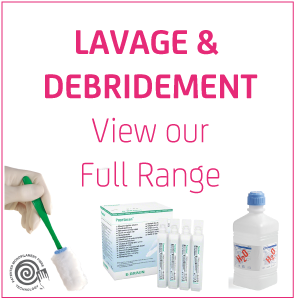
The International Advisory Board on Wound Bed Preparation has developed an assessment tool known by the acronym TIME.
T =Tissue, non-viable or deficient

I= Infection or Inflammation
M= Moisture Imbalance
E = Edge of wound, non-advancing or undermined
This assessment sets out the goals of wound bed preparation, removing non-viable tissue, reducing oedema and exudate, reducing the bacterial load/burden and correcting any abnormalities to promote wound healing. Wound bed preparation offers a structured and systematic approach to assist clinicians when assessing and managing patients with wounds,
(Rowley S, Clare S. Improving standards of aseptic practice through ANTT trust-wide implementation process: a matter of prioritisation and care, J Infect Prevent 2009)
Wound lavage or irrigation is the steady flow of a solution across an open wound surface. It assists with removing devitalised organic matter, inorganic matter and bacteria from the wound. Thereby reducing the amount of debris that the leucocytes have to remove by phagocytosis. When left in situ the debris prolongs the inflammatory phase of wound healing, slowing the formation of granulation tissue and leading to delayed wound healing.
The goal of irrigation is to clean the wound while avoiding direct trauma to the wound bed and driving debris further into the wound bed.
Top 5 tips to effective wound lavage
1. It is suggested via many studies that pressure of 8-12
psi is strong eno
ugh to overcome the adhesive and cohesive forces of bacteria.
2. The volume of irrigation suggested for human wounds is between 50-100mls per cm 2
3. It is recommended that patients are anaesthetised, sedated or given analgesia as required before irrigation of wounds.
4. Ideally, all lavage solutions should be warmed – ideally between 37 0 and 42 0 cels
ius. Did you know it can take a wound up to 40 minutes to reach body temperature after cold irrigation and up to three hours for leukocyte activity to recover!
5. Choosing an appropriate solution is also a critical step in wound irrigation. Ideally, the irrigant should be isotonic, non-toxic, inexpensive, and non-haemolytic. The addition of antiseptic solutions to the irrigation fluid is the subject of considerable controversy, and the cytotoxicity of the antiseptic solution should be considered before use.
At Pioneer, we have curated a range of products ideal for lavaging wounds:
Prontosan contains a PHMB which is an antimicrobial agent as well as including Betaine which is a surfactant. PHMB is active against gram -ve and gram +ve bacteria, fungi and yeast, including MRSA and Pseudomonas aeruginosa.
If anyone has any further questions on the importance of Lavaging wounds or req
uires additional details on our options of products, please don’t hesitate to fill in the enquiry form below, and I can be in touch.









